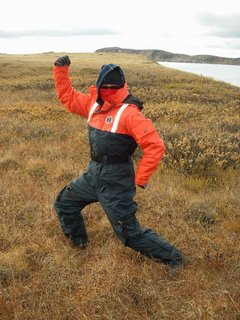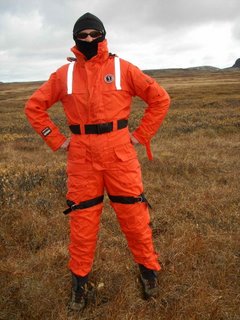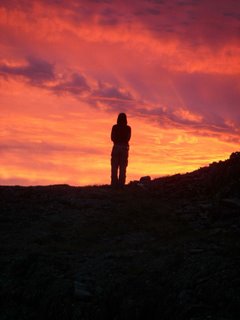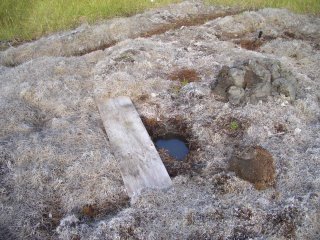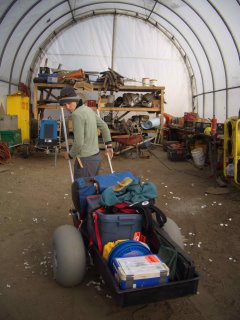A Sad Tale of 5 Motors and 3 Boats or, Why Shepherds Need Whiskey (the Art of Small Motor Repair, Part II)cast of characters:
Heidi and Kathryn, intrepid Arctic researchers
The Golder Fish Dudes, Tim and Paul (lamented in photo and song in a previous entry)
John and Richard - Golder bathymetry engineer and his erstwhile Inuit assistant
Whizzy and Zingy - 15 HP 4-stroke motors
Zippy - 4 HP 2-stroke motor
Pingo and Tussock - 15 HP 2-stroke motors
2 leaky red boats
1 leaky grey boat
key information:
- 2-stroke motors take gas mixed with oil, 4-stroke use straight gas
- inflatable boats of the type we're using get their structure and integrity from floor boards which are held in place by rails that run along each side
Day 5 - Heidi and Kathryn start using Whizzy on one of the Leaky Red Boats. All appears to go smoothly.
Day 7 - We take the second Red Boat out of its box and help Tim and Paul inflate and set it up with Zingy. Unfortunately, the boat comes with only one set of rails so Zingy is handicapped from the beginning. Nonetheless, all appears to go smoothly (leaking like a sieve aside)
Day 10 - Whizzy is damaged in sling between two lakes. Ingenious field repair involving pro-wrap and sport tape (see previous entry) enables us to sample a couple of sites that morning, then we switch to Zippy. Heart of champions, has Zippy, but only 4 - count 'em, 4 - horses; not so speedy.
Day 10 (evening) - we test Pingo and Tussock on our Leaky Red Boat. Tussock turns out to have the run/kill switch broken off (in the run position) - this poses some problems. Ingenious repair job of Whizzy Part II, involving washing machine part and electrical tape (thanks, Paul and Ben!).
John arrives to conduct bathymetry surveys on lakes around here, and is given priority boat. H & K fetch Leaky Grey Boat from bottom end of Windy Lake, whence it has blown and been left abandoned. So now we have Tim and Paul with Zingy (straight gas) on a Leaky Red Boat, John and Richard with Whizzy (straight gas) on the other LRB, and Heidi and Kathryn with Pingo (mixed gas) on the LGB. Imagine, if you will, these three boats jetting back and forth among 15 lakes, with jerry cans and fuel tanks intersecting in the evenings as we each try to get the right fuel in the right tank, and back out to the right boat each day.
Meanwhile, as we zoom about on Golder sampling forays, we are cunningly transporting the gear for Heidi's PhD project, since we are going to the same lakes in helicopters that we will later be visiting on foot. If, for example, we are sampling Doris Lake and Roberts Lake for water quality. Well, we're flying there anyway, so we will take the benthic sampling equipment and one jerry can to Roberts Lake, and some fishing and camping gear to Doris Lake... (planning ahead for which boat will end up where at the end of the Golder work, to get the correct jerry can at each distribution node).
Do you remember that logic puzzle about the shepherd, a sheep, a wolf, one boat, and needing to cross the river?
Day 11. We discover that LGB has no rails for structural integrity - search transects and enquiries in camp reveal that these rails were, in fact, burned during a big garbage purge the previous winter. Yes, burned. Yes, they were aluminum rails. Well, not to be deterred by minor setbacks! We pull a large rusty screw out of LGB's bottom, spend a morning diligently applying 8 patches, gamely mount Pingo, and ship 'er off to Doris Lake to start fishin'. (The shepherd now has 5 sheep distributed on 2 lakes, but still only 1 boat).
Day 12 (morning): We find several suspicously familiar-looking pieces of rubber boat patch washed up on shore next to where we've moored the LGB. It becomes the VLGB (Very Leaky Grey Boat). Not to be deterred by minor setbacks, we head out.
Imagine, if you will, an inflatable rubber boat, that has no rails to hold its floorboards in place. Imagine these floor boards buckling and bouncing as the boat inchworms across the lake. Imagine the great gushes of water flowing in as the rest of the patches wash off. Picture Kathryn, braced against the side of the boat, pushing down with her legs trying to hold the floorboards in place to lend some stability. Picture Heidi, steering with one hand, navigating using the GPS with the other, and bailing the boat with a third (I don't know how she does it, either!). The boat can't get on plane - the motor leg can't get in the water properly - every 50 feet or so, the motor stalls and we all lurch forward (more great gushes of water come rushing over the bow).
"It's like driving an accordion with a sewing machine," Heidi says.
Day 12 (afternoon): We switch Pingo for Zippy. Zippy, big-hearted, but with only 4 - count 'em, 4 - horses, but a longer motor leg.
"It's like driving an accordion with a hand mixer," Kathryn says.
We put Pingo back on (switching jerry cans and fuel tanks appropriately). And, we create a new measurement for time and space. Although the distance we travel each day is, from a cartographic point of view, not far, in terms of logistical nightmares, wrenchingly difficult decisions made, collapse narrowly averted by clawing your way out by the emotional fingernails, and insurmountable obstacles overcome by sheer ingenuity, makes them equivalent to Lewis and Clark Expedition Days.
Day 27 (Day 67, LAC): Richard and John have their LRB, with Whizzy, out in the middle of Patch Lake. To liven the day, they check the oil... Over the radio, Kathryn and Heidi hear, "Yes. Um. Windy Camp. We need a new motor, and 12 long nails."
We look at each other with bemusement. "They're in an
inflatable boat."A new dipstick for Whizzy is ordered (since Patch Lake is about 20 m deep, and, who knew? dipsticks sink when dropped in lakes). LRB #1 switches Whizzy (straight gas) for Tussock (mixed gas). Unfortunately, jerry cans and fuel tanks are not switched, thus making them useless for Whizzy and Zingy in the future. Tussock still has the run/kill switch busted - posing some problems.
Day 39 (Day 90 LAC): Tim and Paul, out of the goodness of their hearts, switch boats with us. Boy, does Zingy zoom in that LRB! Even with her 2-rails-only handicap, it's like going Mach 8...
Day 40: Carey, one of the helicopter engineers in camp, makes new rails for the VLGB (yay, Carey!) out of left-over floor boards from the (retired) other VLGB (burned last winter). Yes, burned. Yes, it was a rubber boat. With these make-shift rails, theVLGB is down-graded to a LGB, and we can get on plane - no more motor stalling! Yippee!
Day 45 (Day 134 LAC): Zingy, sadly, is injured in a lake-to-lake sling: the gear shift is broken. Ingenious Field Repair #2, involving a hollowed-out willow branch, and duct tape. All is well.
Fish Dudes leave (very sad). Zingy, on LRB #2 and with her straight-gas jerry can and fuel tank, goes to Glenn Lake. Pingo, on VLGB and with mixed gas, heads to Roberts Lake. Tussock, on LRB #1, with mixed gas in the formerly straight gas tanks, is busy conducting bathymetric maps of Windy Lake. Whizzy sits in Windy Camp, awaiting union with her new dipstick (which has arrived), and perhaps a new straight gas tank. Zippy, almost empty of mixed gas, sits on shore at Doris Lake, sadly disconnected from a boat. We spend a few days sampling Glenn.
The shepherd now has 8 sheep distributed on 5 lakes, 2 of them with eating disorders, 1 with an injured leg, 2 wolves, and several leaky boats.
Day 47 (Day 236 LAC): We cheerfully arrive for a day of sampling at Roberts Lake, after a lovely trek across the technicolour-fall-leaves-covered tundra. We discover that Pingo and the LGB have broken free from their mooring... and blown across the lake... with the willows we'd tied them to still attached...
Well, once reunited with the boat, we optimistically revved her up - to discover that she had been damaged in her last sling, has a missing carburetor cap, and is leaking too badly to use.
"Heidi," I said, as she tried to build a new carburetor cap out of (you guessed it, pro-wrap and duct tape), and I was trying to remember the various locations of (working) motors, (relatively non-leaky) boats, jerry cans and fuel tanks with which type of fuel, and how to bring the correct combination together at Roberts Lake with a minimum of hiking and helicopter time, "Heidi," I said, "even Hercules only had 12 trials. And Hercules was a demi-god."
PS We don't know what those 12 long nails were for, either.
 Marilynn in her super-suit. This is our finest hour. Water sampling at 2 am on the Arctic Ocean.
Marilynn in her super-suit. This is our finest hour. Water sampling at 2 am on the Arctic Ocean.




